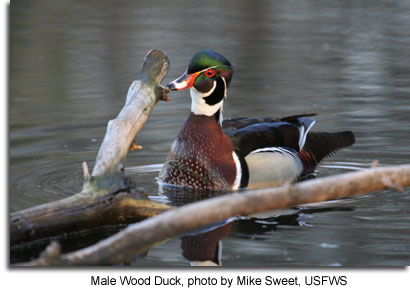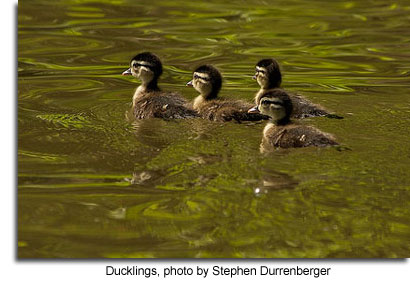To bird lovers all over the country, the male Wood Duck is the most beautiful duck species native to North America. With his brilliant feathers, shimmering with green, violets, browns and blacks highlighted with white, the male Wood Duck seems dressed for a very special occasion. Female Wood Ducks are beautiful in their own right. Females are less colorful with a gray-brown color combined with white-speckled breast.
Wood Ducks are found throughout North America. They are migratory waterfowl which move north in the spring and south in the winter. However, some individuals are year-round Maryland residents.

Natural History
Wood Ducks live in bottomland forests, wooded lakes, rivers, swamps and streams. Occasionally, they can be found in city parks. In the winter, Wood Ducks, aka "woodies", often group together to search for food and shelter. In the spring, males and females will pair up and start nesting activities.
Nests are located no more than a mile from water and are usually placed in tree cavities about 20 to 30 feet above the ground or water surface. Since Wood Ducks cannot excavate their own nesting cavities, they often use old woodpecker holes. Females will then use a combination of debris in the nest cavity as well as down feathers for nesting material. Wood Ducks nest from April to June and lay 9-12 eggs. In areas where nests are really close to each other, females will sometimes participate in “intraspecfic brood competition”. This term means that they will lay their eggs in the nests of other females, leaving the other ladies to raise their young for them. Some nests can then have as many as 29 eggs due to this practice.
In about a month, the eggs will hatch and, within 24 hours, the little ducklings will use their sharp claws to climb out of the nest entrance and fall to the ground or water. Once on the ground, females will lead the ducklings to the nearest body of water. They will not come back to the nest. Wood Duck young can fly about 60 days from hatching. Until that time, their mother looks after them and protects them from harm.

What Do Wood Ducks Eat?
Wood Ducks are dabbling ducks which eat a variety of foods including duckweed, sedge seeds and tubers, grasses, smartweed, wild rice, nuts, fruits, insects and small aquatic animals. Typically, plants make up to 80% of a Wood Duck’s diet. By having the right habitat for Wood Ducks and by providing duck nest boxes, you may attract these beautiful birds without ever having to feed them.
Wood Duck Nest Box
In the early 1900's, loss of mature and dying trees with nesting hollows led to a dramatic decline in Wood Duck populations. When federal and state governments and local wildlife enthusiasts began erecting Wood Duck nest boxes, the birds made a miraculous comeback. If you have a wooded stream or pond on your property or live along a Chesapeake Bay shore with woods nearby, then you may be able to attract Wood Ducks by leaving snags on your property and/or by erecting a Wood Duck nest box.
The
Maryland Wood Duck Initiative (MWDI) is a non-profit volunteer group which partners with the Maryland Department of Natural Resources. MWDI seeks to enhance Wood Duck populations and their habitats throughout Maryland. They have very
detailed nest box plans as well as best management practices available on their website. Since its inception in 2004, thousands of nest boxes and predator guards have been installed on public properties which have provided nesting habitat for thousands of Wood Ducks.

Invite Wildlife to Your Backyard!
Acknowledgements:
- Male Wood Duck, photo by Mike Sweet, USFWS
- Ducklings, photo by
Stephen Durrenberger
- Male Wood Duck, by Maslowsky Photo, USFWS